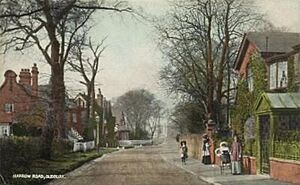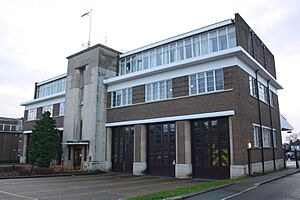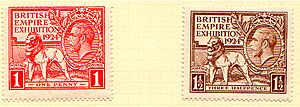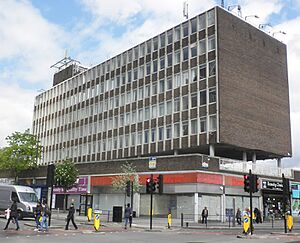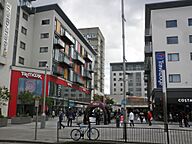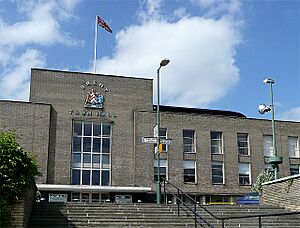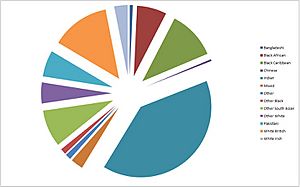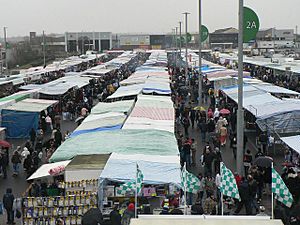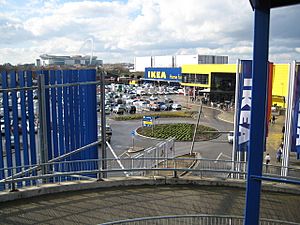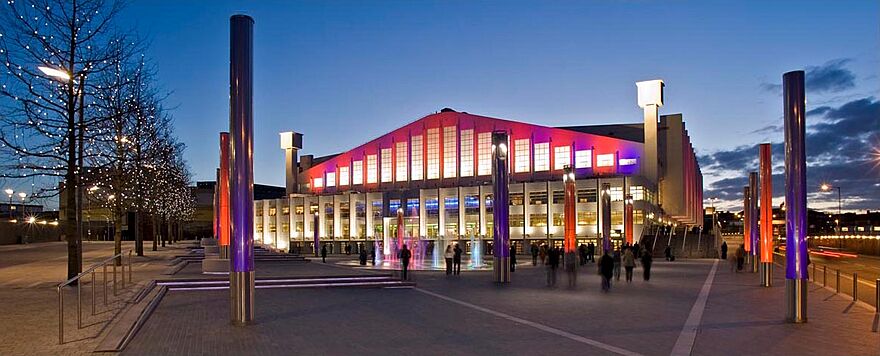Wembley facts for kids
Quick facts for kids Wembley |
|
|---|---|
| Suburb in London | |
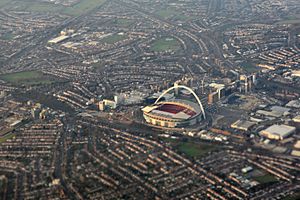 An aerial view of Wembley, showing part of High Road, the industrial estate, Wembley Arena and Wembley Stadium |
|
| Population | 102,856 (2011 Census |
| OS grid reference | TQ175855 |
| London borough | |
| Ceremonial county | Greater London |
| Region | |
| Country | England |
| Sovereign state | United Kingdom |
| Post town | WEMBLEY |
| Postcode district | HA0, HA9 |
| Dialling code | 020 |
| Police | Metropolitan |
| Fire | London |
| Ambulance | London |
| EU Parliament | London |
| UK Parliament |
|
| London Assembly |
|
Wembley is a large area in north-west London, England. It is about 8 miles (13 km) north-west of central London. Wembley is part of the London Borough of Brent and has a population of over 100,000 people. It includes several smaller neighbourhoods like Alperton and Wembley Park.
For more than 800 years, Wembley was part of the parish of Harrow on the Hill. It started as a small farming area. In the mid-1800s, railways arrived, and Wembley began to grow. By the 1920s, it was a large suburb of London with many shops. In 1965, Wembley joined with another area called Willesden to form the London Borough of Brent.
Wembley Park was once a large pleasure ground. In 1924, it hosted the British Empire Exhibition, which led to the building of famous landmarks. These include the original Empire Stadium, which later became Wembley Stadium. This stadium became a very famous place for football. A new, modern Wembley Stadium with a huge arch opened in 2007. It is now the home of the England national football team and hosts major events like the FA Cup final. In recent years, a new shopping area called the London Designer Outlet was also built here.
Contents
Wembley's History
| ◄ Separated from Harrow on the Hill | |
| 1901 | 4,519 |
|---|---|
| 1911 | 10,696 |
| 1921 | 16,187 |
| 1931 | 48,561 |
| ◄ Kingsbury area added (1934) | |
| 1939 | 112,563 |
| 1951 | 131,384 |
| 1961 | 124,892 |
| Note: No census in 1941 due to war | |
| Source: UK census/The 1939 Register | |
What's in a Name?
The name "Wembley" comes from old English words. "Wemba" was a person's name, and "lea" meant a meadow or clearing. So, Wembley means "Wemba's meadow." The name was first written down in the year 825.
The Old Village
Wembley started as a small village on a hill, surrounded by farms and woods. In 1547, there were only six houses in Wembley. Even though it was small, it was one of the richest parts of Harrow. The land was owned by the Page family for many years. They even hired a famous landscape designer, Humphry Repton, to create what is now Wembley Park. The name "Wembley Park" came from Repton calling the areas he designed "parks."
The first long-lasting pub in Wembley was the Barley Mow, recorded in 1722.
How Wembley Grew with Railways
In 1837, the first railway line opened through Wembley, connecting London to other cities. The local station, first called 'Sudbury', changed its name several times to show Wembley's growing importance. It became 'Wembley Central' in 1948, just in time for the 1948 Summer Olympics.
More railway lines opened over the years, including the Metropolitan Railway in 1880, which brought the Wembley Park station in 1894. Today, Wembley has several train and tube stations, making it easy to travel around London.
In 1846, the church of Saint John the Evangelist was built, and Wembley officially became its own parish (a local area with its own church).
In 1905, another railway line opened, and a new station called 'Wembley Hill' was built. This station was close to where Wembley Stadium would later be built. The stadium opened in 1923 for the FA Cup Final. 'Wembley Hill' station was later renamed 'Wembley Stadium' in 1987.
Wembley also had trams and trolleybuses, which were electric buses that ran on overhead wires. Today, many bus routes serve the area, including route 18, which is one of London's busiest.
The old fire station, built in 1937, is a special building with a unique design. It is still used as a fire station today.
Wembley used to have many factories making things like tools and electrical appliances. However, most of these factories closed in the 1980s.
The Empire Exhibition and Stadium
The British Empire Exhibition was a huge event held in Wembley Park in 1924 and 1925. Many buildings were constructed for it, including the first Wembley Stadium. Most of these old buildings have now been removed to make way for new developments.
Most homes in Wembley are semi-detached houses (joined to one other house) or terraced houses (joined in a row). There are also many modern apartment blocks.
The town centre continued to grow. A large cinema, the Majestic Theatre (later Odeon Wembley), opened in 1929. It was later replaced by a shop. Another cinema, The Regal, showed Bollywood films for a while before being taken down in 1987.
Wembley Today: A Modern Look
In the 1960s, Wembley Central station was rebuilt, and a shopping area with flats and a car park was added. Over time, Wembley's main shopping street, the High Road, faced challenges as new shopping centres opened nearby.
However, Wembley has a large and active Indian community, and their jewellery shops on Ealing Road are very popular.
Making Wembley Better
In the early 2000s, big plans were made to make Wembley better. This project aimed to improve the shopping areas and build new homes. The first part of this plan was finished in 2009, creating a new public square and new shops. The whole project was completed in phases until 2015.
The Brent Civic Centre, a new building for the local council, was finished in 2013 near the stadium. Many old council offices were then closed and replaced with new apartments.
The main focus of the regeneration is the "Wembley Park" area, which includes Wembley Stadium and Wembley Arena. The original Wembley Stadium was taken down in 2003, and the new one opened in 2007. The SSE Arena, a concert venue built in 1934, has also been updated while keeping its special Art Deco style.
How Wembley is Governed
Wembley is part of the London Borough of Brent. This means it is governed by the Brent Council, which looks after local services like schools and parks.
Wembley used to be part of the large area of Harrow on the Hill. In 1894, Wembley became its own separate area. In 1937, it became a "municipal borough," which is a type of town council. The Wembley Town Hall was built in 1938. In 1965, Wembley joined with another area called Willesden to form the London Borough of Brent.
Wembley's Green Spaces
Until the 1800s, Wembley was mostly countryside. Today, it has many green spaces for people to enjoy. These include:
- King Edward VII Park (opened in 1914)
- Barham Park
- One Tree Hill Park
- Sudbury Green
- Brent River Park / Tokyngton Recreation Ground
There are also larger open spaces like Horsenden Hill, Vale Farm sports ground, and Barn Hill. The Welsh Harp reservoir, created in the early 1800s, is also nearby.
Wembley is divided into six smaller areas called wards: Wembley Central, Alperton, Tokyngton, Barnhill, Preston and Sudbury. It is located west of Harlesden and Willesden, and south of Kenton. It is also east of Greenford and Northolt.
 |
North Wembley, Harrow on the Hill, Harrow | Wembley Park, Preston, Kenton | Wembley Park, Kingsbury |  |
| Sudbury, North Greenford, Northolt | Neasden, Dollis Hill, Willesden | |||
| Perivale, Greenford | Alperton, Ealing | Stonebridge, Harlesden |
People of Wembley
Wembley is known for its many different cultures and religions. Many people from Asian, Afro-Caribbean, and Eastern European backgrounds live here. In 2011, about 86% of the people in the Wembley Central area were from Black, Asian, or other minority ethnic groups. The largest religion in Wembley Central was Hinduism (45%), followed by Christianity (25%). The most common foreign language spoken was Gujarati.
While some parts of Wembley have faced challenges, recent improvements have helped these areas. Other parts of Wembley, like Barn Hill and Sudbury Court Estate, are very well-off.
Local News
You can find local news about Wembley in the Brent & Kilburn Times and the Harrow Times. These newspapers are available in print and online.
Shopping and Business
Wembley's main shopping area is along High Road and Ealing Road. Ealing Road is especially known for its South Asian jewellery and gold shops, which attract visitors from far away. The newer London Designer Outlet in Wembley Park is also a popular shopping spot, located near the stadium.
Wembley used to have a popular Sunday Market, which ran from the 1970s until 2014. It was closed to make way for new developments.
The IKEA store in Wembley opened in 1988. It was only the second IKEA store to open in the UK.
Sports and Fun
Wembley has two local football clubs, Wembley F.C. and South Kilburn F.C.. Both play at the Vale Farm stadium in nearby Sudbury. There's also the Vale Farm Sports Centre.
Wembley used to have two golf clubs, but they are no longer there. The rugby union club, Wasps RFC, was based in Sudbury from the 1920s until 1996.
Famous Places to See

Besides Wembley's oldest church, St John the Evangelist (built in 1846), another important building is Saint Andrew's Presbyterian Church. Built in 1904, it is now the Central Mosque Wembley. On Ealing Road, you can find the Shree Sanatan Hindu Mandir, a large Hindu temple that opened in 2010.
The Roman Catholic church of Saint Joseph is also a special building.
The Ace Cafe is a famous place for car and motorbike fans. It opened in 1938 and reopened in 1997 after being closed for many years.
Wembley Point, a 21-storey building, was Wembley's first skyscraper, built in 1965. It can be seen from miles away.
A special English Heritage blue plaque on Forty Lane remembers the famous comedian Arthur Lucan.
The most famous landmark is Wembley Stadium, which was rebuilt between 2003 and 2007. You can reach it by walking across the White Horse Bridge. Next to the stadium is the SSE Arena, a concert venue built in 1934 as a swimming pool. It has been carefully updated to keep its original style. The old Wembley Town Hall is now a French school, the Lycée International de Londres Winston Churchill.
Getting Around Wembley
Tube and Train Stations
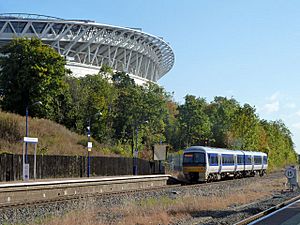
Wembley has several train and London Underground (Tube) stations:
- Wembley Stadium (for Chiltern Railways trains)
- Wembley Central (for Bakerloo line, Southern, West Midlands Trains, and Watford DC line)
- North Wembley (for Bakerloo line and Watford DC line)
- Wembley Park (for Jubilee line and Metropolitan line)
- Sudbury Town (for Piccadilly line)
- Preston Road (for Metropolitan line)
- Alperton (for Piccadilly line)
- Stonebridge Park (for Bakerloo Line and Watford DC line)
Bus Services
Many Transport for London bus routes run through Wembley's High Road. These include routes 18, 79, 83, 92, 182, 204, 223, 224, 297, 483, H17, and the night route N18.
Road Connections
Wembley is very close to the A406 North Circular Road. The A404 Harrow Road also goes through the town centre. There are several car parks available.
Accessing SSE Arena
To get to Wembley Arena, you can use Wembley Park tube station or Wembley Stadium railway station. You can also walk from Wembley Central station across the White Horse Bridge. Bus route 92 stops right outside the Arena. There are also car parks nearby.
Education
To find out about schools in Wembley, you can look at the List of schools in Brent.
Famous People from Wembley
Many well-known people have lived in or come from Wembley:
- British Actor Ricardo P. Lloyd grew up here.
- Politician Luciana Berger grew up in Wembley.
- Drummer Charlie Watts from The Rolling Stones was born here.
- Engineer John Barnard, who helped create new car designs for Formula One, was born in Wembley.
- Actor Riz Ahmed, known for films like Four Lions, was born in Wembley.
- Scientist John D Barrow, a professor at Cambridge University, was born in Wembley.
- Composer Peter Fribbins was born and grew up here.
- British ambassador to Israel Matthew Gould grew up in Wembley.
- Astrologer Russell Grant lived in Wembley.
- Scholar Vivian H. H. Green, who inspired a character in spy novels, was born in Wembley.
- Actor and comedian Lenny Henry lived in Wembley.
- Actor and musician Gary Holton lived in Wembley.
- Footballers Raheem Sterling, Jerel Ifil, and Jerome Thomas lived in Wembley.
- Musician John Lingwood, drummer in Manfred Mann's Earth Band, was born here.
- The actor Arthur Lucan, famous as 'Old Mother Riley', lived in Wembley.
- Rock drummer Keith Moon of The Who was born in Wembley.
- Singer Maxine Nightingale was born in Wembley.
- Figure-skater Valda Osborn was born here.
- Nurse and writer Claire Rayner lived in Wembley.
- Dancer and bandleader Victor Silvester was the son of a vicar in Wembley.
- Composer John Tavener was born in Wembley.
- Musician Harvey Shield grew up in Wembley.
- Mick Whelan, a trade union leader, lives in Wembley.
- Sir Henry Cooper, a British Heavyweight Boxing Champion, opened a shop in Wembley after a famous boxing match.
Images for kids
See also
 In Spanish: Wembley para niños
In Spanish: Wembley para niños




